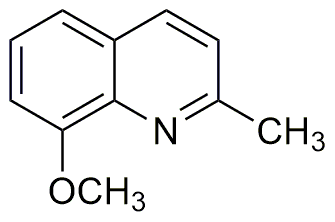8-Methoxy-2-methylquinoline is widely utilized in research focused on:
- Pharmaceutical Development: This compound serves as a precursor in the synthesis of various pharmaceuticals, particularly those targeting neurological disorders, due to its ability to interact with specific receptors in the brain.
- Fluorescent Probes: It is used in the development of fluorescent probes for biological imaging, allowing researchers to visualize cellular processes in real-time, which is crucial for understanding disease mechanisms.
- Antimicrobial Agents: The compound exhibits antimicrobial properties, making it a candidate for developing new antibacterial and antifungal agents, addressing the growing concern of antibiotic resistance.
- Material Science: In material science, it is incorporated into coatings and polymers to enhance their chemical resistance and stability, which is beneficial in various industrial applications.
- Organic Electronics: Its unique electronic properties make it suitable for use in organic light-emitting diodes (OLEDs) and organic solar cells, contributing to advancements in energy-efficient technologies.
General Information
Properties
Safety and Regulations
Applications
8-Methoxy-2-methylquinoline is widely utilized in research focused on:
- Pharmaceutical Development: This compound serves as a precursor in the synthesis of various pharmaceuticals, particularly those targeting neurological disorders, due to its ability to interact with specific receptors in the brain.
- Fluorescent Probes: It is used in the development of fluorescent probes for biological imaging, allowing researchers to visualize cellular processes in real-time, which is crucial for understanding disease mechanisms.
- Antimicrobial Agents: The compound exhibits antimicrobial properties, making it a candidate for developing new antibacterial and antifungal agents, addressing the growing concern of antibiotic resistance.
- Material Science: In material science, it is incorporated into coatings and polymers to enhance their chemical resistance and stability, which is beneficial in various industrial applications.
- Organic Electronics: Its unique electronic properties make it suitable for use in organic light-emitting diodes (OLEDs) and organic solar cells, contributing to advancements in energy-efficient technologies.
Documents
Safety Data Sheets (SDS)
The SDS provides comprehensive safety information on handling, storage, and disposal of the product.
Product Specification (PS)
The PS provides a comprehensive breakdown of the product’s properties, including chemical composition, physical state, purity, and storage requirements. It also details acceptable quality ranges and the product's intended applications.
Certificates of Analysis (COA)
Search for Certificates of Analysis (COA) by entering the products Lot Number. Lot and Batch Numbers can be found on a product’s label following the words ‘Lot’ or ‘Batch’.
*Catalog Number
*Lot Number
Certificates Of Origin (COO)
This COO confirms the country where the product was manufactured, and also details the materials and components used in it and whether it is derived from natural, synthetic, or other specific sources. This certificate may be required for customs, trade, and regulatory compliance.
*Catalog Number
*Lot Number
Safety Data Sheets (SDS)
The SDS provides comprehensive safety information on handling, storage, and disposal of the product.
DownloadProduct Specification (PS)
The PS provides a comprehensive breakdown of the product’s properties, including chemical composition, physical state, purity, and storage requirements. It also details acceptable quality ranges and the product's intended applications.
DownloadCertificates of Analysis (COA)
Search for Certificates of Analysis (COA) by entering the products Lot Number. Lot and Batch Numbers can be found on a product’s label following the words ‘Lot’ or ‘Batch’.
*Catalog Number
*Lot Number
Certificates Of Origin (COO)
This COO confirms the country where the product was manufactured, and also details the materials and components used in it and whether it is derived from natural, synthetic, or other specific sources. This certificate may be required for customs, trade, and regulatory compliance.


